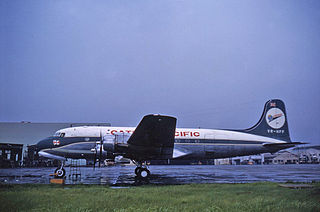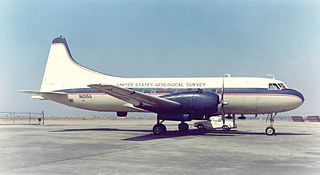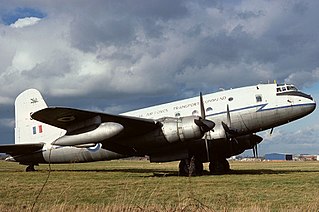
Air Florida Flight 90 was a scheduled U.S. domestic passenger flight operated by Air Florida from Washington National Airport to Fort Lauderdale–Hollywood International Airport, with an intermediate stopover at Tampa International Airport. On January 13, 1982, the Boeing 737-222 registered as N62AF crashed into the 14th Street Bridge over the Potomac River.

Eastern Air Lines Flight 401 was a scheduled flight from New York JFK to Miami. Shortly before midnight on December 29, 1972, the Lockheed L-1011-1 TriStar crashed into the Florida Everglades, causing 101 total fatalities. Three of the four cockpit crew members, two of the 10 flight attendants, and 96 of the 163 passengers were killed; 75 people survived.

The Handley Page HP.67 Hastings is a retired British troop-carrier and freight transport aircraft designed and manufactured by aviation company Handley Page for the Royal Air Force (RAF). Upon its introduction to service during September 1948, the Hastings was the largest transport plane ever designed for the service.

The British Aerospace 125 is a twinjet mid-size business jet. Originally developed by de Havilland and initially designated as the DH.125 Jet Dragon, it entered production as the Hawker Siddeley HS.125, which was the designation used until 1977. Later on, more recent variants of the type were marketed as the Hawker 800.

On 4 June 1967 a Canadair C-4 Argonaut passenger aircraft owned by British Midland Airways crashed near the centre of Stockport, Cheshire, England. Of the 84 people on board, 72 were killed. It is the fourth-worst accident in British aviation history.

Royal Air Force Abingdon, or more simply RAF Abingdon, is a former Royal Air Force station near Abingdon, Oxfordshire. It is now known as Dalton Barracks and is used by the Royal Logistic Corps.

Pan Am Flight 214 was a scheduled flight of Pan American World Airways from Isla Verde International Airport in San Juan, Puerto Rico, to Friendship Airport near Baltimore, and then to Philadelphia International Airport. On December 8, 1963, the Boeing 707-121 serving the flight crashed near Elkton, Maryland, while flying from Baltimore to Philadelphia, after being hit by lightning. All 81 occupants of the plane were killed. The crash was Pan Am's first fatal accident with the 707, which it had introduced to its fleet five years earlier.

The Learjet 25 is an American ten-seat, twin-engine, high-speed business jet aircraft manufactured by Learjet. It is a stretched version of the Learjet 24.

American Airlines Flight 157, a Douglas DC-6, departed on November 29, 1949, from New York City bound for Mexico City with 46 passengers and crew. After one engine failed in mid-flight, a series of critical mistakes by the flight crew caused the pilot to lose control of the plane during the final approach to a routine stopover at Love Field in Dallas, Texas. The airliner slid off the runway and struck a parked airplane, a hangar, and a flight school before crashing into a business across from the airport. 26 passengers and two flight attendants died. The pilot, co-pilot, flight engineer, and 15 passengers survived.

On 26 June 1950, a Douglas DC-4 Skymaster aircraft departed from Perth, Western Australia, for an eight-hour flight to Adelaide, South Australia. It crashed 22 minutes after take-off, 35 miles (56 km) east of Perth Airport. All 29 occupants were killed in the accident; one initially survived, but died six days later. It was the worst civil aviation accident in Australia.

The 1954 Cathay Pacific Douglas DC-4 shootdown was an incident on 23 July 1954, when Cathay Pacific Flight 94 was shot down by People's Liberation Army Air Force fighter aircraft. The event occurred off the coast of Hainan Island, where the plane was en route from Bangkok to Hong Kong, killing 10 of 19 passengers and crew on board.

The 1957 Aquila Airways Solent crash occurred on the Isle of Wight in England on 15 November. With 45 lives lost, at the time it was the second worst aircraft accident within the United Kingdom, then at the time the worst ever air disaster to occur on English soil.

On October 20, 1977, a Convair CV-240 passenger aircraft ran out of fuel and crashed in a wooded area near Gillsburg, Mississippi, United States. Chartered by the rock band Lynyrd Skynyrd from L & J Company of Addison, Texas, it was flying from Greenville, South Carolina, to Baton Rouge, Louisiana, crashing near its destination.

The Little Baldon air crash occurred on 6 July 1965 when a Handley Page Hastings C1A transport aircraft operated by No. 36 Squadron Royal Air Force, registration TG577, crashed into a field in Little Baldon, near Chiselhampton, Oxfordshire, shortly after taking off from RAF Abingdon. The flight was captained by Flt Lt John Akin. All 41 people aboard, including six crew, perished in the crash, making it the third worst air crash in the United Kingdom at the time.

The Tachikawa air disaster occurred on the afternoon of Thursday, June 18, 1953, when a United States Air Force (USAF) Douglas C-124 Globemaster II aircraft crashed three minutes after takeoff from Tachikawa, Japan, killing all 129 people on board. At the time, the crash was the deadliest in aviation history.

Gabon Express Flight 221 was a scheduled domestic passenger flight which crashed into the Atlantic Ocean on 8 June 2004. The Hawker Siddeley HS 748 was carrying 26 passengers and 4 crew and was flying from Gabon's capital Libreville to Franceville via Port-Gentil when an engine failed. The crew tried to return to Libreville International Airport; however they overflew it and nosedived into the sea. At least 19 people were killed in the crash. It was the second deadliest plane crash in Gabon. Gabon President Omar Bongo declared three days of national mourning in response to the disaster.

The Elvetham air crash occurred on 5 October 1945 when a Consolidated Liberator GR.VI aircraft, serial number KG867, of 311 Squadron Royal Air Force crashed at Elvetham, east of Hartley Wintney, Hampshire, following a fire in one of its engines and fuel starvation to another.

On 3 June 2019, an Antonov An-32 twin engine turboprop transport aircraft of the Indian Air Force en route from Jorhat Airport in Assam to Mechuka in Arunachal Pradesh lost contact with ground control about 33 minutes after takeoff. There were 13 people on board. After a week-long search operation, the wreckage with no survivors was found near Pari hills close to Gatte village in Arunachal Pradesh at the elevation of 12,000 feet (3,700 m).

The 1952 Luqa Avro Lancaster crash was a military aviation accident that occurred in Malta on 30 December 1952 when an Avro Lancaster bomber crashed shortly after takeoff from RAF Luqa into a residential area in Luqa. Three of the four crew members on board the aircraft and a civilian on the ground were killed. The crash also caused extensive property damage. The cause of the crash was engine failure.
























